Chapter 1
Definition of orthodontics and factors influencing orthodontic treatment
Orthodontics is a specialised branch of dentistry. The name comes from two Greek words:
- orthos – meaning straight or proper
- odons – meaning teeth
so the meaning is clear – ‘straight teeth’.
Orthodontics is the study of the variations of the development and growth of the structures of the face, jaws and teeth, and of how they affect the occlusion (bite) of the teeth.
Ideally, there should be the same number of permanent teeth in each arch.
Any deviation from the norm is called:
- a malocclusion, if it affects teeth alignment and the bite relationship
Most malocclusions are genetically caused, i.e. they are inherited, e.g. missing teeth or a protruding mandible.
Other malocclusions can be caused by the patient, e.g. digit sucking or trauma.
Orthodontic treatment can correct a malocclusion by putting the teeth into their normal position and occlusal relationship (with surgical help, if needed) so that:
- the bite is fully functioning and the patient can bite and chew properly
- the oral hygiene is made easier, thus helping to prevent caries and gingivitis
- the malocclusion does not cause other damage
- the patient looks better and has better self-esteem
Orthodontic treatment in conjunction with orthognathic (maxillo-facial) surgery can correct an underlying jaw discrepancy or facial asymmetry.
Figure 1.1 Cephalometric tracing.
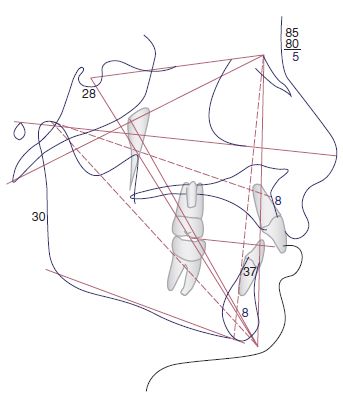
Orthodontic planning is done in conjunction with the surgeons using clinical and radiographic assessment, with a cephalometric tracing (Figure 1.1) often analysed using computer software program.
So, orthodontists set out to:
- straighten teeth
- improve the bite
- improve the function
- improve oral hygiene (and make teeth easier to clean)
- improve self-esteem of the patient
CLASSIFICATION OF OCCLUSION
When assessing occlusion there are two aspects to classification:
- incisor relationship
- buccal segment occlusion, left and right
Both are recorded on a patient’s Orthodontic Assessment Form.
Figure 1.2 Incisor classification.
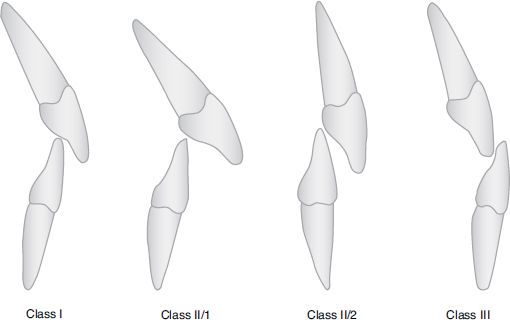
Incisor classification
- Classes have roman numerals, e.g. I, II, III
- Divisions do not, e.g. Class II/1 or Class II/2
The incisor classification (Figure 1.2):
- relates to the bite of the tip of the lower central incisors onto the back of the upper central incisors
- is divided into three horizontal sections and where the lower incisor occludes will determine the classification
Class I
- The incisal edge of the lower incisors bites on or below the cingulum plateau of the upper incisors
Class II/1
- The upper incisors are proclined or upright (Figures 1.3 and 1.4)
- The lower incisors bite behind the cingulum plateau of the upper incisors
- The position of these front teeth means they can be damaged more easily because of their vulnerable position
Figure 1.3 Large overjet.
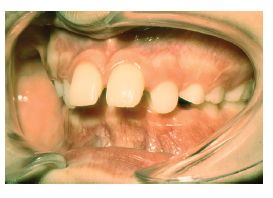
Figure 1.4 Side view of severe overjet.
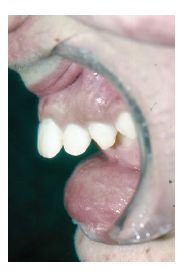
Figure 1.5 Bite stripping lower gingivae.
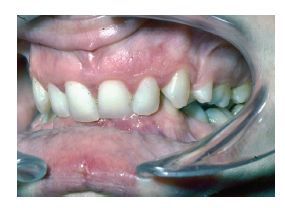
Class II/2
- The upper incisors are retroclined
- The lower incisors bite behind the cingulum plateau
- The position of the teeth can, when closed, lead to trauma to the lower labial gingivae and the upper palatal gingivae (Figures 1.5–1.7)
Figure 1.6 Damage to labial gingivae caused by bite.
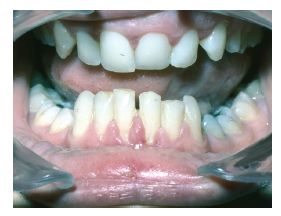
Figure 1.7 Bite causing trauma to the palate.
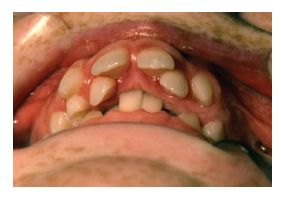
Stay updated, free dental videos. Join our Telegram channel

VIDEdental - Online dental courses


